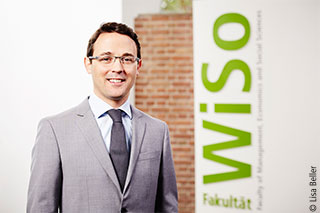The digitised summer term at german universities started on 20 April. The WiSo Faculty already started with online lectures and courses on Monday, 6 April 2020. After the first week of digital teaching, we had already spoken with Professor Hernán Bruno from the Marketing Area.
Dear Professor Bruno,
which lectures have you held since 16 March?
I have conducted eight 3-hour sessions for the Cologne-Rotterdam EMBA programme. My course is called Strategic Marketing Management, and it is a core course for the participants. These participants have an average age of about 35 and are high-potential professionals who attend evening and weekend classes.
On 7 April, I conducted a bachelor lecture for the course Methods of Marketing Mix Management.
How does communication with students work?
We are using different tools to interact with the students. The most obvious one is that we moved the class to Zoom. I host a session and the participants join. I can see their faces, and they are allowed to ask questions and contribute. Sometimes this is done by raising a virtual hand and sometimes spontaneously. The group is made up of about 30 people, so they were able to self-organise and were very respectful of one another.
We also try to enrich communication via asynchronous digital channels. We use the website with a forum feature. I have generated more PDF documents than I normally do. If something cannot be easily translated from the live blackboard to the online blackboard, I try to find a different channel for that content.
What feedback do you receive from the students?
In general, the feedback has been positive. They are aware of how extraordinary the situation is which we are experiencing, how unexpected the switch was, and how everyone is doing their best to maintain the teaching experience. They have been grateful, and I am also grateful to them.
Have you already been able to exchange information and ideas with other lecturers? What experiences have your colleagues had?
We often talk about different modalities. For instance, I have found that a 90-minute lecture in the classroom does not need to be replaced by a 90-minute lecture online using Zoom. Instead, we can do 45 minutes with Zoom, encouraging interaction or demonstration, and then record a 45-minute lecture, perhaps with more technical details, that is uploaded to the course website.
Only two weeks have passed between 16 March and 6 April. This is not much time for the changes that have now taken place. You are a digital environment professor and have been active in executive education for some time now. Last but not least, you have developed entire management education programmes. Have these experiences been of benefit to you now?
We are learning fast and trying out different things. The good thing is that we all understand that we are in this together. So, the students have reacted with patience and are keen to adapt. For instance, I am now learning how to efficiently use different online teaching tools. Even simple things like deciding what to do on an iPad and what to do on a computer can make a difference in the overall experience.
Teaching experience certainly helps. You can predict how students will react, what they expect and what works. But experience only helps to an extent. Understanding students and executive participants is useful, but online teaching at the scale in which we are trying to do it now is truly uncharted territory.
The key is to try things out, learn and iterate.
Where do you see the biggest didactic differences between digital and classroom teaching?
Not being in the classroom makes interaction more difficult. That, in turn, makes executive education a challenge. So, you have to be innovative in order to bring the experience of the participants into the classroom. In real life, one has to manage a discussion in physical ways, with the body, hands, the position in the room. Online, we need to develop new cues.
What advantages do you see in online teaching?
There are advantages, and it has to do with the extra flexibility. I can pre-record segments of the classroom, can easily put students into groups, or I can collect poll data in real time.
Even if classroom teaching starts again, the current digital developments will not be completely reversed but further developed. What potentials does the combination of digital platforms and classroom teaching offer, and what could those responsible at the university do to increase them?
I will definitely use what I have learned from this forced experiment in online teaching. I want to go back to the classroom, because I feel happier being in close proximity with the participants. I want to hear them comment, laugh at jokes, see their physical cues that they do or don’t understand. However, I am planning to combine online elements in order to add flexibility to the learning experience as a whole.
We need to find the hidden opportunities of online teaching, and we need to use this difficult time to emerge stronger and wiser. Difficult times eventually pass, and the important thing is to learn from them and develop new skills.
- more interviews about online teaching at the WiSo Faculty:
- Professor Hernán Bruno's Find an expert page
